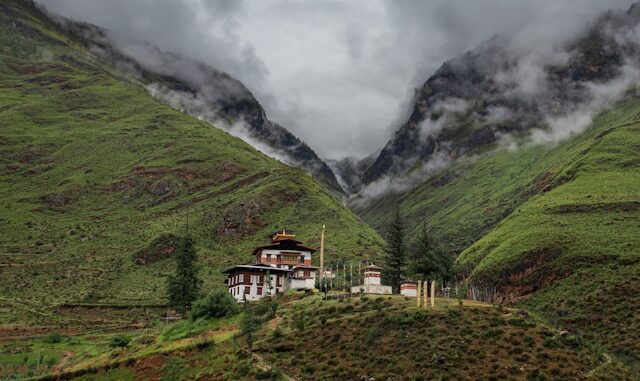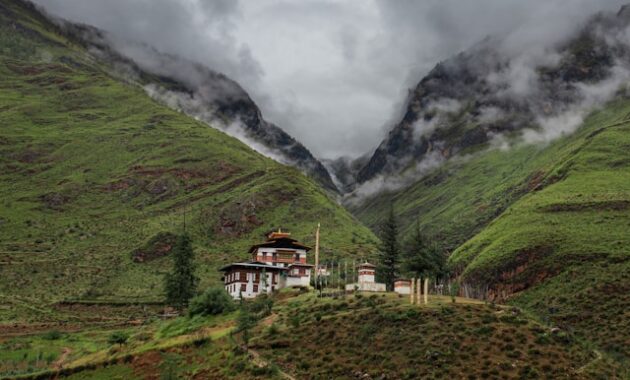
Nestled in the Eastern Himalayas, Bhutan is a landlocked kingdom renowned not just for its gross national happiness, but also for a food culture deeply rooted in Buddhist philosophy, seasonal produce, and holistic living. The Bhutanese cuisine is a harmonious blend of spice, simplicity, and spirituality, reflecting the rugged terrain, high altitudes, and ancient cultural values that define this mystical land.

The Spiritual Foundations of Bhutanese Cuisine
In Bhutan, food preparation and consumption are acts of devotion and mindfulness. The nation’s strong Buddhist traditions influence every aspect of life, including what is grown, how it is cooked, and the rituals that surround it. Meals often begin with a short prayer of gratitude, and meat consumption is approached with reverence due to the Buddhist principle of non-violence (ahimsa). While meat is consumed, most Bhutanese abstain from slaughtering animals themselves, instead relying on imported meat.
Bhutanese cuisine is therefore not just nourishment—it is spiritually informed sustenance, emphasizing respect for all living beings and the land that provides food.
Spices in Bhutanese Cuisine: Fiery Flavors with Purpose
Bhutanese dishes are unapologetically spicy, making chilies the cornerstone of every meal. Unlike in other cultures where chili is a seasoning, in Bhutan, it is often the main ingredient. The Bhutanese even have a saying: “A day without chili is a day without happiness.”
The most commonly used spices and ingredients include:
- Chilies (Ema) – Available in red and green varieties, used fresh or dried. They dominate dishes like Ema Datshi, Bhutan’s national dish.
- Ginger and Garlic – Used for medicinal and flavoring purposes.
- Turmeric – Valued for its anti-inflammatory properties and vibrant color.
- Sichuan Pepper (Thingay) – Offers a citrusy flavor with a numbing sensation, widely used in highland dishes.
These spices are not used merely for taste but are also believed to balance the body’s energy, warm the soul, and promote internal harmony, in line with traditional Tibetan medicine.
Ema Datshi and the Role of Cheese in Bhutanese Cuisine
At the heart of Bhutanese food culture lies Ema Datshi, a comforting and spicy stew made from chilies and homemade cheese. “Ema” means chili and “Datshi” means cheese in Dzongkha, the national language. This dish encapsulates the Bhutanese ethos: simple ingredients with bold character.
Bhutanese cheese is typically made from yak’s milk or cow’s milk and varies in texture from soft and creamy to hard and chewy. Other variants of this dish include:
- Kewa Datshi – Potatoes with cheese.
- Shamu Datshi – Mushrooms with cheese.
These dishes are served with red rice, a native variety cultivated in the Paro Valley, rich in fiber and minerals.
The Simplicity and Purity of Ingredients
One of the most striking features of Bhutanese cuisine is its purity. Most ingredients are organic, locally sourced, and seasonal. Farming in Bhutan is heavily influenced by environmental preservation and sustainability, aligning with the country’s commitment to being the world’s only carbon-negative nation.
Staple ingredients include:
- Red Rice – Nutty and semi-sticky, resistant to Bhutan’s high altitudes.
- Buckwheat – Common in central Bhutan, used in pancakes and noodles.
- Barley – Ground into flour for Tsampa, a traditional roasted flour dish.
- Dried Meats and Vegetables – A method to store food during the long, harsh winters.
Vegetables such as radish, spinach, pumpkin, beans, and cabbage are commonly used. The emphasis is on minimal processing, ensuring maximum nutritional value.
Sacred Meals and Ritual Offerings
Food in Bhutan also plays a central role in religious ceremonies and festivals. Offerings of Torma (ritual cakes made from barley flour and butter) are made during religious rituals to appease deities and spirits. Butter tea (Suja) and sweet rice (Zow Shungo) are commonly served during Tshechus (religious festivals).
The preparation of these sacred foods is often done with specific chants, purification rituals, and under the guidance of Lamas or monks, further integrating spirituality into the Bhutanese culinary narrative.
Fermented and Preserved Foods: Surviving the Himalayan Winters
Given the long and snowy winters, preservation plays a crucial role in Bhutanese food culture. Common methods include:
- Drying – Chilies, turnip leaves, and meats are sun-dried and stored.
- Fermenting – Foods like si datshi (fermented soybean and cheese stew) are popular in the colder months.
- Pickling – Radishes and bamboo shoots are pickled to add zing to winter meals.
These preservation techniques ensure that nutrition and flavor are available year-round, even when the land lies under snow.
Regional Variations in Bhutanese Cuisine
While the national dishes form the foundation, regional variations across Bhutan add richness and diversity to the food culture:
- Western Bhutan (Paro, Thimphu) – More access to dairy and vegetables. Dishes like Shakam Paa (dried beef with chilies) and Phaksha Paa (pork with radish and chilies) are common.
- Central Bhutan (Bumthang) – Known for buckwheat noodles and dishes like Putta and Khuli (buckwheat pancakes).
- Eastern Bhutan – Heavily reliant on fermented bamboo shoots, zow (roasted rice), and stronger flavors due to higher chili tolerance.
These variations showcase Bhutan’s cultural diversity, yet all regions adhere to the same principles of simplicity, spice, and sacredness.
Daily Life and Bhutanese Dining Etiquette
In traditional Bhutanese homes, meals are often eaten seated on the floor, shared among family members, emphasizing community and humility. Hands are commonly used to eat, especially in rural regions. Guests are served first, and it is customary to politely refuse food once or twice before accepting, reflecting Bhutanese modesty and gratitude.
Hospitality is paramount, and offering food is seen as an act of merit and blessing. Sharing meals reinforces the values of compassion and connection that are central to Bhutanese society.
Influence of Modernity and Globalization
Despite its deep-rooted traditions, Bhutan is not immune to modern culinary influences. Urban areas like Thimphu and Paro now feature international cuisines, cafés, and fast food. Yet, the younger generation is encouraged to value their heritage, and many initiatives promote the documentation and preservation of traditional recipes.
Government efforts also focus on promoting organic farming, food sovereignty, and culinary tourism, ensuring that Bhutan’s unique food culture is not lost in globalization’s wake.
Conclusion: A Cuisine of Depth, Devotion, and Distinction
Bhutanese food culture is not just about sustenance—it is a profound expression of the nation’s identity, spirituality, and respect for nature. With its bold use of chilies, reverence for tradition, and emphasis on purity, Bhutanese cuisine offers a window into a harmonious way of life where body, mind, and soul are nourished in unison.